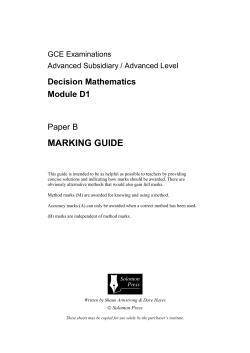
RW746 Solution 8
RW746 Solution 8
1. (20 marks) Exercise 17.4 of the notes.
Given n integers
cn , find a partition of {1, 2, . . . , n} into two subsets S1 , S2 that minimizes the
P c1 , . . . , P
quantity max( j∈S1 cj , j∈S2 cj ).
Consider the following heuristic for some fixed integer k:
1. Choose the k largest cj ’s.
2. Find the optimal partition of these k integers (by some exhaustive method).
3. Complete this into a partition of {1, 2, . . . , n} by considering each of the remaining cj ’s
and adding it to the partition which at the time has the smallest sum.
(a) (10 marks) Prove that this O(2k + n) algorithm is
1
2+k -approximate.
(b) (10 marks) Based on the previous question, devise an approximation scheme for this problem.
What is the complexity of your PTAS, in terms of n and 1/?
This problem was clearly too hard to do. I am not going to give the solution here and it will not
be marked as part of the tutorial. It also won’t be considered for the exam.
1
2. (20 marks)
Suppose we are given an n×n grid graph G, as in the figure.
Associated with each node v is a weight w(v), which is a
nonnegative integer. You may assume that the weights of
all nodes are distinct. Your goal is to choose an independent
set S of nodes of the grid, so that the sum of the weights
of the nodes in S is as large as possible. (The sum of the
weights of the nodes in S will be called its total weight.)
Consider the following greedy algorithm for this problem.
1. Start with S equal to the empty set.
2. While some node remains in G:
2a.
Pick a node vi of maximum weight
2b.
Add vi to S
2c.
Delete vi and its neighbours from G
3. Return S.
(a) (10 marks) Let S be the independent set returned by the algorithm above, and let T be any other
independent set in G. Show that, for each node v ∈ T , either v ∈ S, or there is a node v 0 ∈ S so
that w(v) ≤ w(v 0 ) and (v, v 0 ) is an edge of G.
Consider any v ∈ T . If v ∈ S, then we are done. So let’s assume that v 6∈ S.
(1) At least one of the up to four neighbours of v must be in S; otherwise, we could increase
the total weight of S by adding v to S.
(2) So, let’s suppose that the neighbours of v are {v1 , . . . , vk }. Either k = 2 (in case v is a
corner node), k = 3 (in case v is an edge node), or k = 4 (in case v is an interior node).
(3) Rewind the algorithm to the point just before any of the neighbours are selected by
the greedy algorithm. In the next step, the algorithm selects vi . Therefore w(v) ≤ w(vi )
(otherwise v would have been selected), and (v, vi ) (because vi is a neighbour of v).
(b) (10 marks) Show that the greedy algorithm returns an independent set of total weight at least
1/4 times the maximum total weight of any independent set in the grid graph G.
Consider any other independent set T (including the optimal set). For each node v ∈ T , we
charge it to a node in S as follows. If v ∈ S, then we charge v to itself. Otherwise, by (a), v
is a neighbour of some node v 0 ∈ S whose weight is at least as large. We charge v to v 0 .
Now, if v is charged to itself, then no other node is charged to v, since S and T are independent
sets. Otherwise, at most four neighbouring nodes of no greater weight are charged to v. Either
way, the total weight of all nodes charged to v is at most 4w(v). Since these charges account
for the total weight ogf T , it follows that the total weight of nodes in T is at most four times
the total weight of nodes in S.
Total: 20 marks
2
© Copyright 2025





















